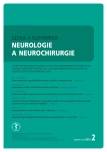Clinical Recognition of Spinal Lipoma and Surgical Treatment in Our Patient Cohort
Authors:
J. Chochol 1; M. Smrek 1; P. Bartoň 2; P. Sýkora 3; M. Kabát 1; J. Chochol 4; D. Dúbravová 1; E. Štefánková 1; L. Zábojníková 1; J. Trnka 1; F. Horn 1
Authors‘ workplace:
Klinika detskej chirurgie LF UK a DFNsP Bratislava
1; Klinika detskej urológie LF UK a DFNsP Bratislava
2; Klinika detskej neurológie LF UK a DFNsP Bratislava
3; Neurochirurgická klinika LF UK a UN Bratislava
4
Published in:
Cesk Slov Neurol N 2016; 79/112(2): 207-212
Category:
Short Communication
Overview
Aim:
To introduce the topic of spinal lipoma. To evaluate neurological and urodynamic status before and after surgery in a cohort of patients. To evaluate benefits of prophylactic performance or patient observation.
Methods:
Authors present a retrospective study pf a set of 25 patients with spinal lipoma in the lumbosacral region. The patients were examined at the Department of Paediatric Surgery at DFNsP Bratislava within three years. The data from the cohort were statistically processed and neurological and urodynamic states evaluated.
Outcomes:
Our set consisted of 25 patients, 14 girls and 11 boys. 22 patients had surgery. Twenty one children had one surgery, and one girl had three surgeries due to worsening of neurological function. Neurological status of two patients worsened and improved in four patients. Neurological deficit completely ceased in six patients, another six patients had no changes, and four patients remained asymptomatic. Urological status was asymptomatic in eleven patients, it improved in six and remained unchanged in five patients. Urological status did not worsen in any patient.
Conclusion:
Due to diverse treatment modalities available, spinal lipomas are a controversial group of congenital diseases of the spine and spinal cord. Despite a surgical intervention, the status of some patients deteriorates. Our set of patients is too small to conclude. Nevertheless, it seems that prophylactic intervention can be suggested to younger children.
Key words:
spina bifida – spinal lipoma – filum terminale – spinal cone tethered cord
The authors declare they have no potential conflicts of interest concerning drugs, products, or services used in the study.
The Editorial Board declares that the manuscript met the ICMJE “uniform requirements” for biomedical papers.
Sources
1. Horn F. Spina bifida: kaudálne defekty neurálnej rúry. Bratislava: Vydavateľstvo M. Vaška 2008.
2. Šteňová J, Kubíková E. Topograficko-anatomické vzťahy chrbtice, miechy a miechových nervov, význam pre klinickú prax. Neurol Prax 2009;10(4):205– 8.
3. McLone D, Thompson D. Lipomas of the spine. In: McLone D (ed.). Pediatric Neurosurgery. Philadelphia: WB Saunders 2001:289– 301.
4. Horn F, Chochol J, Smrek M, et al. Spinálne lipómy – operovať alebo observovať? Neurol Prax 2014;15(Suppl 1):19– 21.
5. Jeffrey PB, Scott E. Spinal lipomas. Alabama: Neurosurg Focus 2001;1:10.
6. Chochol J. Spina bifida: problematika spinálneho lipómu. Diplomová práca. Bratislava: LF UK 2014.
7. Smrek M, Vidiščák M. Skryté vrodené spinálne malformácie. Acta Spondilologica 2003;2(2):92– 4.
8. Oakes W. Management of spinal cord lipomas and lipomyelomeningoceles. In: Wilkins RH, Rengachary SS (eds). Neurosurgery Update II. New York: McGraw-Hill 1991:3497– 504.
9. Lellouch-Tubiana A, Zerah M, Catala M, et al. Congenital intraspinal lipomas: histological analysis of 234 cases and review of the literature. Pediatr Dev Pathol 1999;2:346– 52.
10. Horn F, Babala J, Smrek M, et al. V akom veku operovať pacientov so spinálnym lipómom? Čs Pediat 1999;54(11):632– 4.
11. Foster S, Kogan A, Cogen H, et al. Bladder function in patients with lipomyelomeningocele. J Urol 1990;143(5):984– 6.
12. Atala A, Bauer B. Bladder functional changes resulting from lipomyelomeningocele repair. J Urol 1992;148(2):592– 4.
13. Satar N, Bauer B. Shefner J, et al. The effects of delayed diagnosis and treatment in patients with an occult spinal dysraphism. J Urol 1995;154(2):754– 8.
14. Valentini LG. Occult spinal dysraphism: lessons learned by retrospective analysis of 149 surgical cases about natural history, surgical indications, urodynamic testing, and intraoperative neurophysiological monitoring. Childs Nerv Syst 2013;29(9):1657– 69. doi: 10.1007/ s00381-013-2186-5.
15. Čihák R. Anatomie 3. Druhé, upravené a doplněné vydání. Praha: Grada Publishing 2004.
16. Hajnovič L, Trnka J. Tethered spinal cord syndrome – the importance of time for outcomes. Eur J Pediatr Surg 2007;17(3):190– 3.
17. Pierre-Kahn A, Zerah M, Renier D, et al. Congenital lumbo-sacral lipomas. Childs Nerv Syst 1997;13(6): 298– 335.
18. Kumar A, Mahapatra A, Satyarthee G. Congenital spinal lipomas: role of prophylactic surgery. J Pediatr Neurosci 2012;7(2):85– 9. doi: 10.4103/ 1817-1745.102562.
Labels
Paediatric neurology Neurosurgery NeurologyArticle was published in
Czech and Slovak Neurology and Neurosurgery

2016 Issue 2
- Metamizole vs. Tramadol in Postoperative Analgesia
- Memantine in Dementia Therapy – Current Findings and Possible Future Applications
- Memantine Eases Daily Life for Patients and Caregivers
- Metamizole at a Glance and in Practice – Effective Non-Opioid Analgesic for All Ages
- Advances in the Treatment of Myasthenia Gravis on the Horizon
Most read in this issue
- Ramsay-Hunt Syndrome – a Rare Manifestation of Relatively Frequent Condition
- Transient Ischemic Attack and Minor Stroke Management
- Neurosarcoidosis in a Middle-aged Man – a Case Report
- Autonomic Dysfunction and its Diagnostic Tools in Multiple Sclerosis
